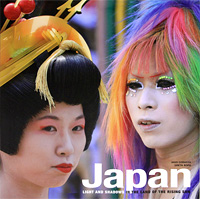We journeyed in Japan. We traversed architectural solutions that connect parallel urban worlds, including the capsule syndrome. We proceeded by exploiting the national efficiency and pride for celebrated means of transportation and by observing the social consequences of a space managed to integrate individuals with the alien units of a large metropolis.
We watched our reflections in panels of mirrored glass works of modern architecture in a country reborn from the ruins left by war and earthquakes, losing ourselves in the new identities of reproduced districts metastasized across the huge megalopolis. But above all, we lost the way while looking for a street between the reality and the tradition that govern the life of Japanese.
For us it was impossible to do what to them comes naturally: abandon the contemplative enchantment of cherry blossoms to immerse oneself in the secret nocturnal embrace of the metropolis. It is difficult to follow with ones gaze the ephemeral geishas who, with rapid steps, pass through the doors of the welcoming tea rooms, or the unyielding, solemn advances of the young shopping warriors, who get gobbled up by the electric doors of 10-story fashion malls. It"s touching to observe the couples, joined through arranged marriages, seeking a bit of intimacy in the love hotels, and paying with credit cards dedicated to manga heroes. Ubiquitous, the consolation of omnipresent vending machines dispensing drinks, flowers, food, books, toys, or religious relics. One becomes accustomed to amazement in a country with a Zen aesthetic and a technological democracy, contemplating the harmony of ikebana and fleeing from anachronistic taboos that endure among the superstitions. It is easy to slip into the alleyways, into the districts of the water trade, where sex is lived as an entertainment free of all sin. It is important to understand how this country - which has made the sense of belonging to a community an absolute banner - has been able to transform a great economic crisis into a reality of super-work and, again, a technological revolution into a great economic crisis.
This is a place where every gesture is weighed and calibrated to ensure and preserve the delicate equilibrium between public and private.
This is a place where utmost religious tolerance reigns, where every credo is welcomed, where it is possible to be born Shintoist, marry Catholic, die Buddhist.
This is the country that was able to rise again from atomic ashes and scale the peaks of world economy, but which, today, must reinvent the concept of memory.
This is Japan. Это и многое другое вы найдете в книге Japan: Light and Shadows in the Land of the Rising Sun (Iago Corazza, Greta Ropa)
